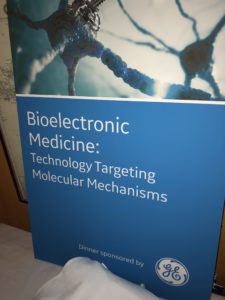 Technology is changing the world, including the world of pharmacological therapies that target molecular mechanisms. These therapies are expensive, difficult to administer, often toxic, and may be accompanied by lethal side effects. Through a convergence of molecular medicine, neuroscience and bioengineering, bioelectronic medicine seeks to develop cures that don’t require drugs or rely on them less heavily.
Technology is changing the world, including the world of pharmacological therapies that target molecular mechanisms. These therapies are expensive, difficult to administer, often toxic, and may be accompanied by lethal side effects. Through a convergence of molecular medicine, neuroscience and bioengineering, bioelectronic medicine seeks to develop cures that don’t require drugs or rely on them less heavily.
The second symposium, Bioelectronic Medicine: Technology Targeting Molecular Mechanisms was held June 12-14 in Saltsjöbaden, Sweden, presented by the Feinstein Institute for Medical Research, the Karolinska Institutet, and the Journal of Internal Medicine.
The field of bioelectronic medicine is aimed at interfacing electronics with nerves to specifically target the biological processes underlying disease. Bioelectronic medicine is now at a crossroads of the future of medical research where healthcare, technology and science join.
“With the discoveries that have been announced, and the research collaborations that are spanning the globe, the pace of bioelectronic medicine is accelerating,” said Kevin J. Tracey, MD, president and CEO of the Feinstein Institute and Editor in Chief of Bioelectronic Medicine. “As the global scientific home of bioelectronic medicine, it is important that the Feinstein Institute host a forum to discuss new findings and drive new discovery. We achieved that goal with this latest symposium.”
The three-day meeting brought together leading scientists and global experts from major institutions as well as industry leaders in biotechnology, including Galvani Bioelectronics, General Electric, GlaxoSmithKline, Medtronic and SetPoint Medical. The goal was to explore, define, and further develop the field of bioelectronic medicine. Session topics included: Defining Circuits, Clinical Updates, Molecular Targets, Neural Interfaces, Signal Processing, Disruptive Tools and Technology, and Accelerating Clinical Translation.
I am inspired by the science, by the field advances, and by our collaborations in the short time since our groups hosted the last meeting in 2016.
Peder Olofsson, MD, PhD
Presenters were encouraged to show their most recent advances. Many of the presentations included unpublished data, sparking thought-provoking discussion while contributing excitement about the latest developments in the field. At least one presenter was interrupted by spontaneous applause midway through the presentation. “I am inspired by the science, by the field advances, and by our collaborations in the short time since our groups hosted the last meeting in 2016,” said Peder Olofsson, MD, PhD, director of the Center for Bioelectronic Medicine at the Karolinska Institutet, and a chair of the symposia.
The meeting culminated with a talk given by Ms. Kelly Owens, a patient with a device implant for Crohn’s Disease. She described her disease diagnosis, treatment, and experience with a vagus nerve stimulator. Her story was inspiring and a reminder that patients are the lynchpins of translational research.
Ms. Owens is not the only patient to benefit from this therapy. SetPoint Medical, a clinical-stage biomedical technology company developing bioelectronic therapy for chronic inflammatory diseases, recently announced positive clinical results in a proof-of-concept study using bioelectronic medicine to treat Crohn’s disease. Sixty percent of patients achieved significant reductions in disease activity. Shortly following that data, SetPoint Medical reported positive long-term results from its clinical study to treat Rheumatoid Arthritis with bioelectronic medicine.
Co-chair of the meeting, Chad Bouton, co-director of the Feinstein Institute’s Center for Bioelectronic Medicine noted that, “this meeting marks a major advance in our field and for using electrons to cure patients with diseases ranging from inflammation to paralysis.”
In his concluding remarks, Dr. Peder Olofsson commented the field of bioelectronic medicine began at the interface of immunology and neuroscience, but now requires input from numerous disciplines to bring bioelectronic medicines to life. Dr. Olofsson identified four current areas of focus for the field: the mapping of functional circuits, the improvement of interfaces, the de-convolution of neural signals, and the acceleration of translating discoveries to the clinic.
By forming global collaborations and combining technologies spanning disciplines, we step closer to reproducing a drug’s therapeutic reaction – mobilizing the body’s natural reflexes to develop effective, safe and economical alternatives to pills and injectables.
The next Bioelectronic Medicine symposium is being planned for 2020 in New York. Further information will be available from the Feinstein Institute and the Karolinska Institutet in due course.
#BioelecMed2020
Comments